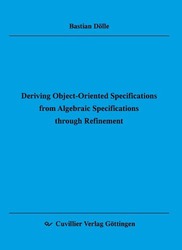| Departments | |
|---|---|
| Book Series (96) |
1379
|
| Nachhaltigkeit |
3
|
| Gesundheitswesen |
1
|
| Humanities |
2367
|
| Natural Sciences |
5407
|
| Mathematics | 229 |
| Informatics | 319 |
| Physics | 980 |
| Chemistry | 1364 |
| Geosciences | 131 |
| Human medicine | 243 |
| Stomatology | 10 |
| Veterinary medicine | 108 |
| Pharmacy | 147 |
| Biology | 835 |
| Biochemistry, molecular biology, gene technology | 121 |
| Biophysics | 25 |
| Domestic and nutritional science | 45 |
| Agricultural science | 1004 |
| Forest science | 201 |
| Horticultural science | 20 |
| Environmental research, ecology and landscape conservation | 148 |
| Engineering |
1793
|
| Common |
98
|
|
Leitlinien Unfallchirurgie
5. Auflage bestellen |
|
Advanced Search
Deriving Object-Oriented Specifications from Algebraic Specifications through Refinement (English shop)
Bastian Dölle (Author)Preview
Table of Contents, Datei (44 KB)
Extract, Datei (88 KB)
This thesis presents a formal method how to refine algebraic specifications into object-oriented specifications in a systematic way. Thereby, we highlight the conceptual differences between algebraic specifications and object-oriented modeling. The correctness of the refinement step is established by preserving the models of the algebraic specification respecting a natural semantic relation. The thesis also comprises a basic system model for object-oriented systems and a comprehensive case study demonstrating the refinement step. Moreover, we survey the prototype system ASIOS which is an interactive tool mechanizing the transformation of algebraic specifications into object-oriented specifications.
The basic system model for object-oriented systems serves to precisely define the semantics of object-oriented specifications. This way, it lays the formal foundation for the proof of the correctness of the transformation.
The applicability of the transformation is demonstrated by a case study using the well-known abstract data type "stacks of natural numbers’’. We investigate the transformation for characteristic design choices of the respective design space, and we present object-oriented classes which provide interpretations for the resulting object-oriented specifications. Furthermore, we give an implementation of each of these classes in the object-oriented programming language JAVA.
All transformation procedures have been implemented in the prototype system ASIOS. The tool supports the transformation process with a graphical user interface providing the necessary guidance for the programmer in making various design choices. ASIOS includes an editor for entering algebraic specifications in CASL notation which is realized as an Eclipse plug-in. The tool results with UML class diagrams and sequence diagrams that can be exported as XMI files.
The thesis shows that algebraic specifications can be refined into object-oriented specifications in a profound way. The transformation bridges the gap between functional specification concepts and object-oriented modeling techniques, and thus contributes to a better understanding of object-oriented software construction. Moreover, an important area of application comprises the mechanized top-down development of software components.
| ISBN-13 (Printausgabe) | 3867274525 |
| ISBN-13 (Hard Copy) | 9783867274524 |
| ISBN-13 (eBook) | 9783736924529 |
| Final Book Format | A5 |
| Language | English |
| Page Number | 174 |
| Edition | 1 Aufl. |
| Volume | 0 |
| Publication Place | Göttingen |
| Place of Dissertation | Lübeck |
| Publication Date | 2007-12-12 |
| General Categorization | Dissertation |
| Departments |
Mathematics
Informatics |
| Keywords | Algebraic specifications, object-oriented specifications, refinement of specifications, UML, software components |








